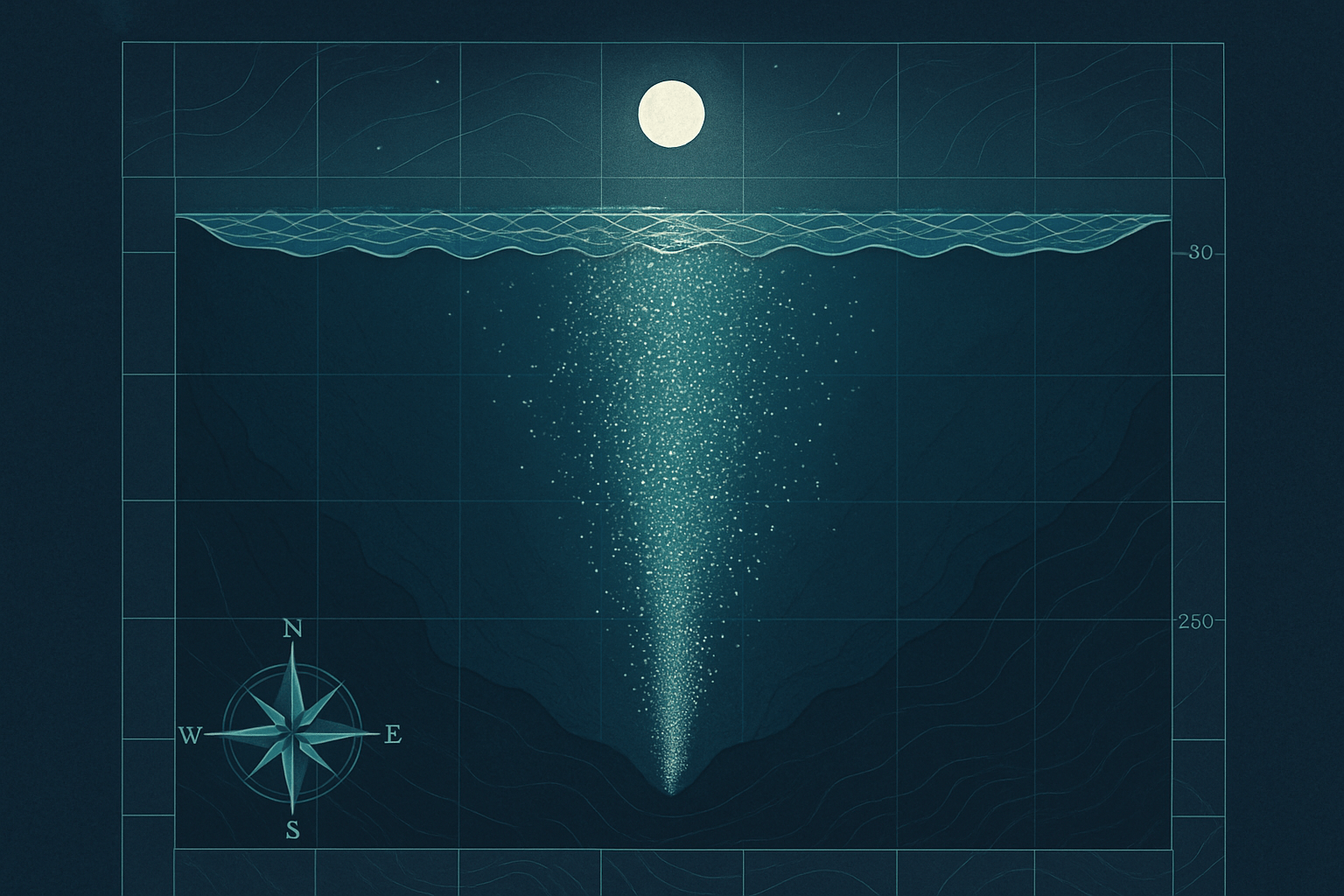The Phantom Bottom: A World War II Mystery
Our story begins not with a biologist, but with naval sonar operators during World War II. While scanning the ocean depths, they were baffled by a consistent and perplexing phenomenon: a “false bottom” that would appear on their screens, hundreds of meters below the surface. Stranger still, this phantom seabed would rise toward the surface as dusk fell, only to retreat back into the abyss at dawn. For a time, it was a military mystery, a ghost in the machine. But this wasn’t a geological feature or an enemy submarine fleet; it was life. They had inadvertently discovered the Deep Scattering Layer (DSL).
The DSL isn’t a solid layer at all. It’s a densely packed, moving mass of living organisms. The sound waves from the sonar were bouncing off the bodies and swim bladders of countless small fish, shrimp, jellies, and squid. From the coasts of California to the middle of the Indian Ocean, from the frigid waters of the Norwegian Sea to the warm currents of the South Pacific, this layer exists. Its exact depth varies based on the geography of the location—specifically, the clarity of the water. In clearer, tropical waters, the layer may descend to nearly 1,000 meters (3,300 feet) to escape the sun’s penetrating rays. In murkier or polar regions, it might only be 200-300 meters deep.
This daily movement defines a vast, mobile ecosystem, a living, breathing geographical feature that swells and shrinks with the rhythm of the sun.
Meet the Commuters: Life in the Twilight Zone
So, who are these trillions of daily commuters? The cast of characters comes primarily from the ocean’s mesopelagic, or “twilight zone”—the region between 200 and 1,000 meters where sunlight barely penetrates. The participants include:
- Zooplankton: Tiny crustaceans like copepods and krill, which form the foundation of the ocean food web.
- Lanternfish: Perhaps the most abundant vertebrate on the planet, these small fish are named for their light-producing organs (photophores), which dot their bodies in unique patterns, creating a silent, starry light show in the deep.
- Bristlemouths: Another incredibly numerous group of small, deep-sea fish known for their formidable, bristle-like teeth.
- Squid and Jellyfish: Gelatinous hunters that also make the daily journey, preying on smaller migrators along the way.
The motivation for this colossal journey is a fundamental trade-off between food and safety. The surface waters, the sunlit epipelagic zone, are rich in their food source: phytoplankton. These microscopic plants form the base of the marine food web but require sunlight for photosynthesis. However, this well-lit dining room is also teeming with visual predators like tuna, swordfish, and sharks.
So, the commuters have evolved a clever strategy. They spend their days hiding in the dark, cold depths, safe from predators. As the sun sets, they begin their massive, synchronized ascent to the surface to feast on the plankton buffet under the relative safety of night. Before the sun rises again, they must complete their return journey to the deep, a race against the light and the predators it brings. It’s a life dictated by the vertical geography of risk and reward.
Earth’s Carbon Express: A Planetary Service
This daily commute is far more than just a fascinating quirk of marine biology; it’s a vital component of the Earth’s climate system. The Diel Vertical Migration is a primary driver of the biological carbon pump, one of the planet’s most important natural mechanisms for mitigating climate change.
Here’s how this global service works:
- Intake: At the surface, phytoplankton absorb enormous amounts of carbon dioxide (CO2) from the atmosphere through photosynthesis.
- Consumption: The vertical migrators swim up at night and consume these carbon-rich phytoplankton.
- Transport: They then transport that carbon within their bodies back down to the deep ocean.
- Sequestration: In the deep, they respire, releasing some CO2. Crucially, they also excrete fecal pellets—tiny, carbon-packed parcels that sink rapidly to the seafloor. When these creatures die, their bodies also sink, carrying their stored carbon with them.
By actively moving this carbon from the surface to the deep, the DVM prevents it from being quickly re-released into the atmosphere. It effectively locks it away in the deep ocean, where it can remain sequestered for hundreds or even thousands of years. Scientists estimate this process transports billions of tons of carbon into the ocean’s interior every year, an amount comparable to the carbon footprint of entire continents. Without this tireless, nightly commute, the concentration of CO2 in our atmosphere would be significantly higher.
A Human Connection to the Deep
Though it happens far from human eyes, the Diel Vertical Migration is deeply intertwined with human geography. Major fishing grounds around the world, from the Grand Banks off Newfoundland to the rich waters off Peru and Japan, are dependent on it. The large, commercially valuable fish that support coastal economies and cities follow the DSL. Tuna and swordfish track this dense layer of food, meaning the geography of the world’s fisheries is, in part, dictated by the geography of this daily migration.
Furthermore, this critical planetary function is vulnerable to human-caused climate change. Warming surface waters can create a stronger thermal barrier, making the vertical journey more energy-intensive for these tiny creatures. Ocean acidification threatens the plankton at the base of their food chain. The consequences of disrupting the world’s largest migration could be immense, affecting everything from global fisheries to the ocean’s ability to absorb carbon.
As we continue to map our planet, it’s humbling to remember that some of its most significant geographical features are not static mountains or rivers, but dynamic, living phenomena. The Diel Vertical Migration is a silent, daily testament to the intricate and powerful connections that link the smallest of creatures to the largest of planetary systems—a hidden commute that makes life on Earth possible.
